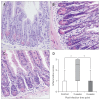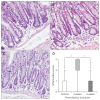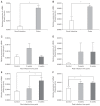Piezo2: A Candidate Biomarker for Visceral Hypersensitivity in Irritable Bowel Syndrome?
- PMID: 28044050
- PMCID: PMC5503296
- DOI: 10.5056/jnm16114
Piezo2: A Candidate Biomarker for Visceral Hypersensitivity in Irritable Bowel Syndrome?
Abstract
Background/aims: Currently, there exists no biomarker for visceral hypersensitivity in irritable bowel syndrome (IBS). Piezo proteins have been proven to play an important role in the mechanical stimulation to induce visceral pain in other tissues and may also be a biomarker candidate. The aim of this study was to test the expressions of Piezo1 and Piezo2 proteins in the intestinal epithelial cells from different intestinal segments and to explore the correlation between Piezo proteins expression and visceral pain threshold.
Methods: Post-infectious IBS was induced in mice via a Trichinella spiralis infection. Visceral sensitivity was measured with abdominal withdrawal reflex to colorectal distention. Inflammation in the small intestine and colon was scored with H&E staining. Expression location of Piezo proteins was confirmed by immunohistochemistry. Abundance of Piezo proteins were measured with real-time reverse transcriptase polymerase chain reaction.
Results: Piezo1 and Piezo2 proteins were expressed in the intestinal epithelial cells. The expression levels of Piezo1 and Piezo2 were abundant in the colon than the small intestine (P < 0.001 for Piezo1, P = 0.003 for Piezo2). Expression of Piezo2 in the colon significantly correlated to the visceral sensitivity (r = -0.718, P = 0.001) rather than the mucosal inflammation.
Conclusion: Piezo2 is a candidate biomarker for visceral hypersensitivity in IBS.
Keywords: Hyperalgesia; Ion channels; Irritable bowel syndrome; Piezo2 protein, human; Pizeo1 protein, human.
Conflict of interest statement
Figures







References
LinkOut - more resources
Full Text Sources
Other Literature Sources

